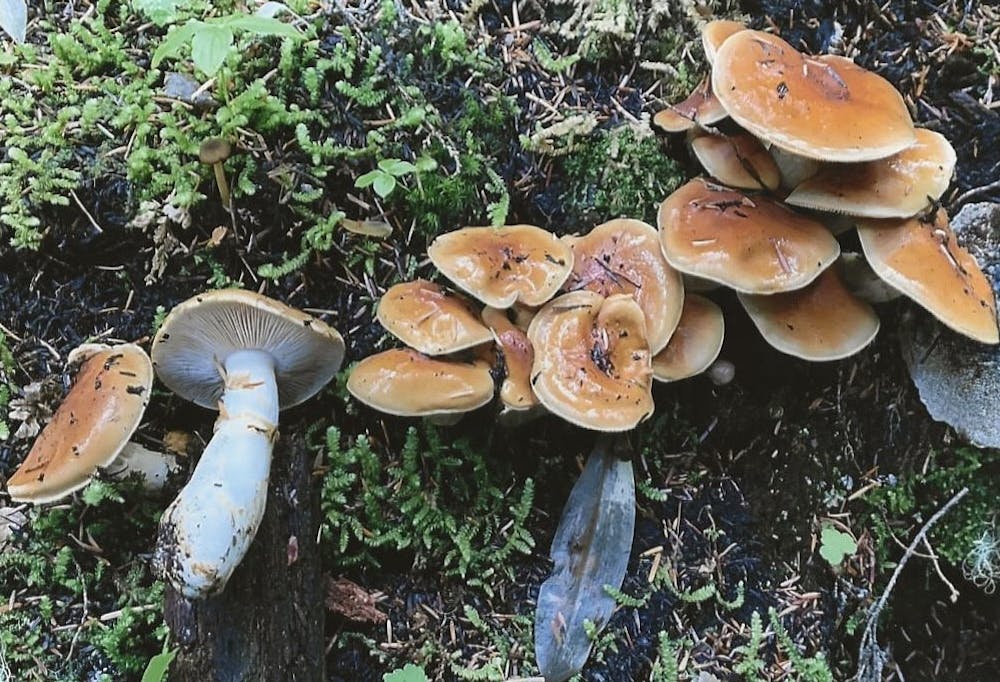The Northwest Mushroomers Association is hosting its 31st annual Wild Mushroom Show in the Viking Union at Western Washington University this Sunday, Oct. 22, from 11 a.m. to 5 p.m. This is the association’s first show after a four-year hiatus due to COVID-19.
The show will feature mushroom identification, edibility recommendations and presentations by mycologists, or fungi researchers.
“There’s a lot of tireless hours which go into this show,” said Jack Waytz, vice president of the association. “We’re just trying to make it a good experience where people will go away from it knowing a lot more than when they came in.”
Waytz, who’s been a member since 2001, and a forager before that, said he has gotten a great deal out of the Northwest Mushroomers Association since joining.
“I love the aspects of being out in the field,” Waytz said. “Since getting into this group I’ve found 13 mushrooms which are new to science so far. So those are exciting things for me.”
Fred Rhoades, a former biology professor at Western and a member of the association, described identifying mushrooms as a process that takes practice to master.
“There’s no easy way to identify an edible versus poisonous mushroom,” Rhoades said. “You have to learn them as individuals.”
This is a skill that the experts at the show have experience with – if attendees have mushrooms in their yard that they are curious about, this show presents an opportunity to have them possibly identified.
Rhoades will be at the show running a lichen table, which also has the interactive aspect of bringing in samples for him to identify. Lichen is a combination of fungi and algae with about 3,600 different species across North America according to the U.S. Forest Service. Along with lichen, the show has a variety of different tables for other spores and fungi.
“If people are interested in slime molds, there will be a slime mold table – there’s going to be lots of interesting places to check out,” Rhoades said.
The Wild Mushroom Show has been a yearly tradition since its conception, making these last four years difficult for the group as the pandemic forced a hiatus.
“It’s kind of a club function, everybody volunteers to do something,” Rhoades said. “It’s been so long, many of the new members don’t know what it’s like. It’s always fun because usually, the general public has no idea how many kinds of mushrooms there really are.”
For Western students who find fungi, plant life and foraging interesting, the WWU Foraging Club is a good place to pursue that curiosity.
“Teaching other people about the world around you is a communal experience,” said Kiera Parnell, president of the club. “There’s definitely this magic associated with finding a mushroom patch and having it be yours.”
The club, which meets on Tuesdays at 4 p.m. in the Outdoor Classroom in the Outback Farm, allows students to safely explore the world of searching for their own food. Whether it’s mushrooms, berries or fish, there are all sorts of foods the club hopes to scavenge for.
“Part of it for me and a lot of college students is that food is really expensive, especially vegetables,” Parnell said. “It’s cool to just be able to go and get your own and cut down on food costs.”
The Wild Mushroom Show costs $10 for adults $7 for students and seniors. Kids 12 years or younger get in for free and there will be tables specifically for children.
“People I think have been kind of hungry for us to do another show since it’s been a few years,” Waytz said. “So I anticipate we’re going to have at least 1,000 people show up.”
Rhoades thinks the show will open people up to the world of fungi but also hopes that people are respectful if they adopt foraging as a hobby.
“You would think the number of mushrooms you see out in the woods is an unlimited resource, but it isn’t,” Rhoades said. “So we have to treat it kindly; that is, to not take everything that one sees, but to practice ethical collecting.”
Waytz agrees with this sentiment and is careful about his impact on the environment when he forages.
“The relationship we have with everything else that lives here, we need to improve that,” Waytz said. “When I go out to forage for mushrooms I want it to be nearly impossible to see that I was there.”
Alex Hodson (he/him) is a city news reporter for The Front this quarter. He is a second-year pre-major in journalism. When not working on The Front, he likes to play pickleball, watch movies, drink coffee and sing in Western's Concert Choir. You can reach him at alexhodson.thefront@gmail.com






